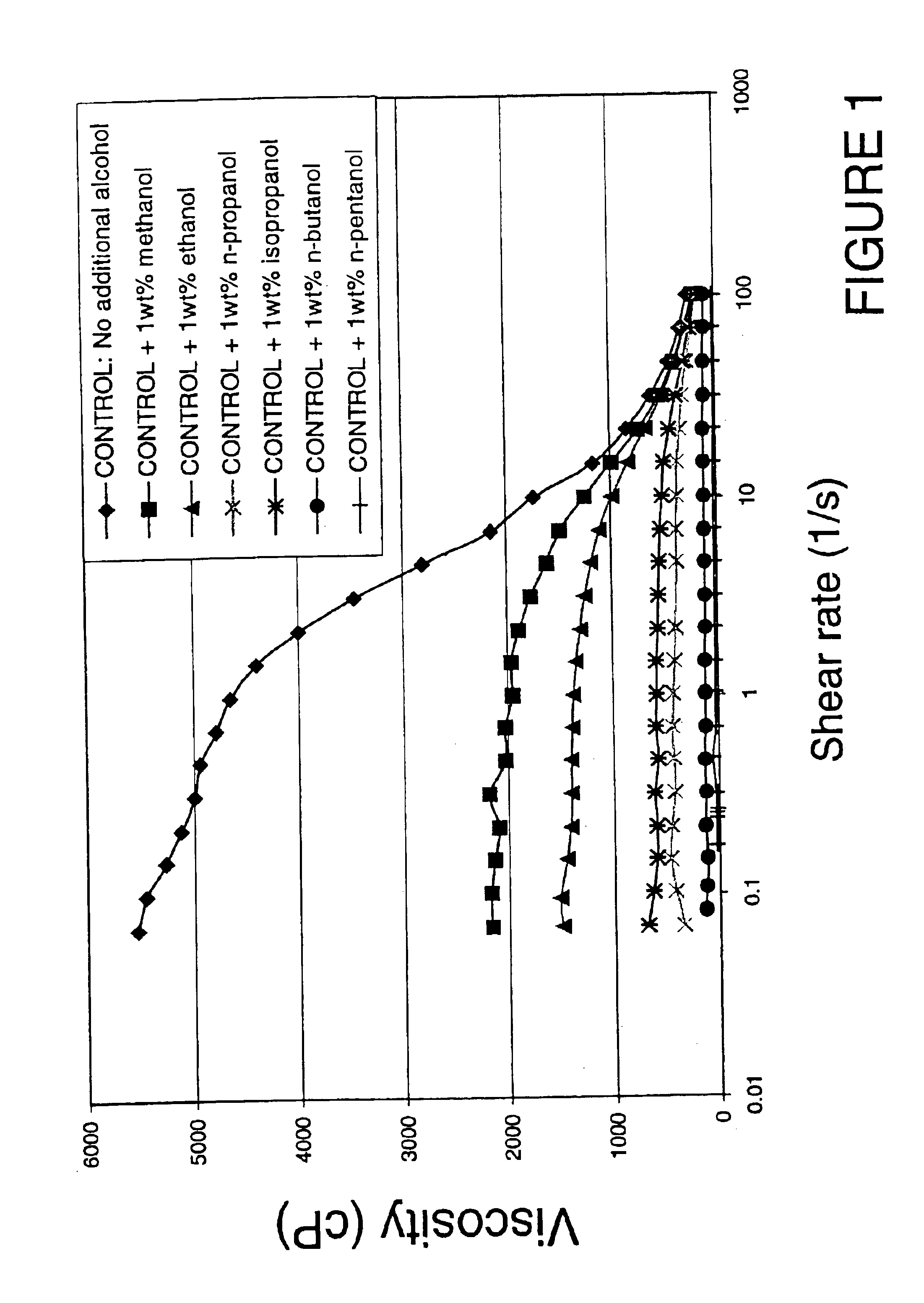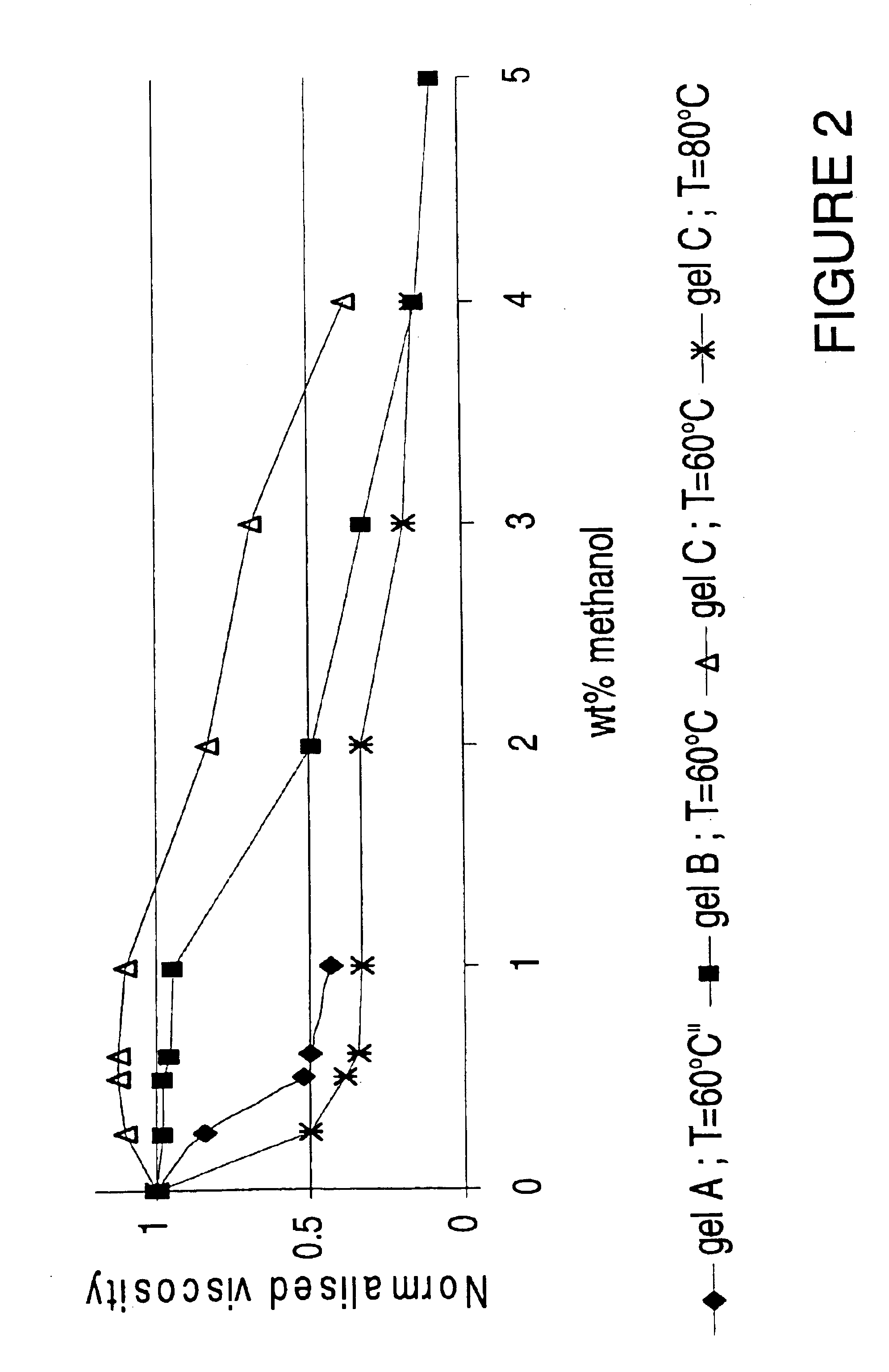Viscosity reduction of viscoelastic surfactant based fluids
a technology of viscoelastic surfactant and viscoelastic surfactant, which is applied in the field of viscoelastic surfactant (ves) fluid viscosity reduction, can solve the problems of reducing production and reducing formation permeability, and achieve the effects of reducing the viscosity, enhancing the effectiveness of the main fluid, and improving or optimizing conditions
- Summary
- Abstract
- Description
- Claims
- Application Information
AI Technical Summary
Benefits of technology
Problems solved by technology
Method used
Image
Examples
example 1
Addition of Alcohol
[0057]The viscosity of an aqueous solution comprising viscoelastic surfactants consisting of long chain quaternary ammonium salts is reduced by the addition of alcohol. FIG. 1 shows the effect of adding various alcohols on the flow rheology of a typical viscoelastic surfactant based gelling composition containing 3 wt % erucyl methyl bis(2-hydroxyethyl) ammonium chloride (EMHAC), 1 wt % isopropanol and 3 wt % ammonium chloride.
[0058]All tested alcohols significantly decrease the viscosity at low shear-rate, with an efficiency increasing with increasing chain length (C1 to C5).
[0059]With the smaller chain length alcohol (especially with methanol and ethanol), at higher shear-rate the fluid viscosity is essentially the same as the one measured for the reference fluid with no alcohol. It is believed that during fracture creation, most fracturing fluids are subject to a shear rate between about 20 and 150s−1—and consequently the addition of alcohol makes it possible t...
example 2
Addition of Ether
[0061]The method relies on the use of an ester (R′COOR″) which has little effect on the rheology of the viscoelastic gel but which can decompose to generate alcohol (R″OH) at a concentration greater than or equal to the critical concentration required to break the gel, where R′ and R″ are aromatic, saturated or unsaturated hydrocarbon chains.
R′COOR″+H2O→R′COOH+R″OH
[0062]Since some organic acids may also efficiently break a gel comprising a VES (see Example 3), addition of ester can be very effective, provided the hydrolysis occurs at an appropriate time. A similar effect can be achieved by using the appropriate dibasic or tribasic ester.
[0063]FIG. 3 shows the effect of adding various methyl diesters to gel B defined in Example 1. In contrast to the more hydrophobic diesters (dimethyl glutarate, dimethyl adipate, dimethyl diethyl malonate and dimethyl azelate), the more hydrophilic esters (dimethyl itaconate, dimethyl malonate, dimethyl malate and dimethyl oxalate) h...
example 3
Addition of a Salt of an Organic Acid
[0065]Some organic acids are efficient gel breaker. The acid can be provided encapsulated or as a salt. Then, under acidic conditions, the following reaction occurs:
RCOO−+H+→RCOOH
[0066]The salt shall be selected so that RCOO−has little or no effect as an effective counterion in the viscoelastic gel. Examples of suitable anions are:[0067]salicylate anion / salicylic acid: 2-(HO)C6H4COO−+H+→2-(HO)C6H4COOH[0068]adipate anion / adipic acid: −OOC(CH2)4COO−+2H+→HOOC(CH2)4COOH[0069]versatate anion / versatic acid: C9H19COO−+H+→C9H19COOH[0070]glutarate anion / glutaric acid: −OOC(CH2)3COO−+2H+→HOOC(CH2)3COOH
[0071]In this example, the initial fluid pH is greater than the pKa of the carboxylic acid so that the concentration of RCOO− is greater than the concentration of RCOOH. At the appropriate time, lower pH conditions are generated so that the concentration of RCOOH increases and becomes greater than the concentration of RCOO−. Lower pH conditions can be generat...
PUM
| Property | Measurement | Unit |
|---|---|---|
| temperatures | aaaaa | aaaaa |
| concentration | aaaaa | aaaaa |
| concentration | aaaaa | aaaaa |
Abstract
Description
Claims
Application Information
 Login to View More
Login to View More - R&D
- Intellectual Property
- Life Sciences
- Materials
- Tech Scout
- Unparalleled Data Quality
- Higher Quality Content
- 60% Fewer Hallucinations
Browse by: Latest US Patents, China's latest patents, Technical Efficacy Thesaurus, Application Domain, Technology Topic, Popular Technical Reports.
© 2025 PatSnap. All rights reserved.Legal|Privacy policy|Modern Slavery Act Transparency Statement|Sitemap|About US| Contact US: help@patsnap.com



